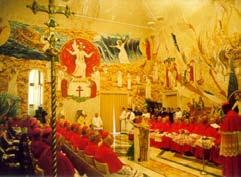
33 minute read
a Grateful Response
a Grateful Response liturgy & the life of the church Architecture projects the structure of the Mass
The medieval arrangement for monastic churches typically placed the altar against the wall at the far East end of the church. From the altar the long rows of choir stalls stretched deep into the church and were arranged such that the monks on one side faced those on the other side of church. Thereafter, the laity occupied the nave and looked through the monastic choir to the distant altar.
When the Jesuit order was founded, its members were dispensed from saying the daily hours of prayers together, that they might be free for active ministry. Accordingly, Jesuit churches such as Il Gesù in Rome have no choir, and the nave was brought right up close to the altar. This allowed the laity far more immediate access to the altar than the medieval monastic arrangement.
When our Abbey Church was built in 1957 it anticipated the liturgical reform that was soon to be mandated by the Second Vatican Council (1962-1965). The altar in our church is placed between the choir and the nave, giving a new centrality to the altar. In many ways our altar is more like the free standing altars from Christian antiquity in the major basilicas of Rome.
Another way our church anticipated the coming renewal was by placing the tabernacle in its own chapel, in close proximity to the altar, yet in an area as distinct as the eucharistic liturgy is related to yet distinct from the reservation of the consecrated bread.
The way in which we use our church, moreover, has developed, as monks no longer fill the choir stalls, and we are able to welcome all our guests to join us in the choir stalls for our weekday celebrations of the Eucharist.
The way in which we use our church for weekday and Sunday celebrations of the Eucharist, furthermore, is subtly attuned to the liturgical renewal following Vatican II. In fact, the model we use parallels that used in the latest papal chapel to be dedicated in the Apostolic Palace, at the Vatican.
That chapel, called the Redemptoris Mater, or Mother of the Redeemer, chapel is arranged like our choir, with the chairs in parallel rows facing the center aisle so that the people on one side face those on the other. In that chapel, the freestanding altar is placed at the far end of the center aisle, as it is placed relative to our monastic choir. In that chapel the lectern is placed in the center of the choir seating, so that the Word of God is The Redemptoris mater Chapel in the Apos tolic Palace in Vatican City - proclaimed from the midst of the assembly, and the presidential chair is placed at the opposite end of the choir and facing toward the lectern.
The arrangement of our choir for the celebration of the Eucharist is similar in that the lectern is placed in the center aisle of the choir, but at one end so as to form the hinge-pin between the choir and the altar. Our presidential chair is also located opposite the altar and facing the lectern.
In both arrangements, the presider sits or stands at the chair in the midst of the assembly to listen to the readings proclaimed from the lectern. Thus, there is a direct relationship between the lectern Father Daniel McCarthy and the assembly, and between the lectern and the presidential chair.
The altar, then, is located beyond this choir arrangement for the liturgy of the Word, as the eucharistic liturgy is both distinct from the liturgy of the Word, yet so intimately related to the liturgy of the Word as to form one liturgy.
The arrangement of both the new papal chapel and our monastic chapel agrees with statements made by the Council in the Constitution on the Sacred Liturgy, Sacrosanctum Concilium, which say: “There is to be a revision of the way the mass is structured, so that the specific ideas behind the individual parts and their connection with one another
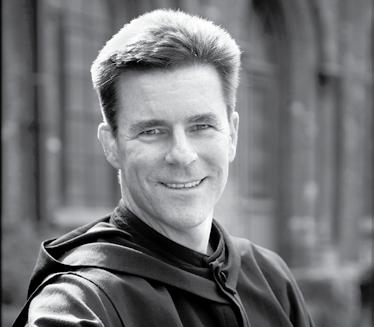
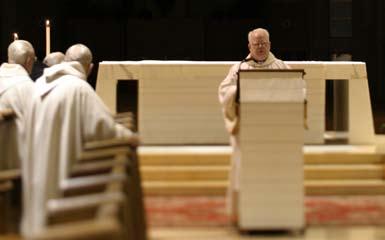
Father Maurice Haefling reads the Gospel at Mass in the Abbey Church.
can be more clearly apparent, and so that it becomes easier for the people to take a proper and active part” and “The two parts which in some way go to make up the mass, namely the liturgy of the Word and the liturgy of the Eucharist, are so closely bound up with each other that they amount to one single act of worship” (nº 50, 56 Decrees of the Ecumenical Councils, 2 vol., ed. N. Tanner, Georgetown UP, Washington DC 1990).
Thus, the structure of the architecture in both chapels expresses the structure of the Mass itself. When the renewed order of Mass was developed after the Council by the Consilium appointed by Pope Paul VI, one of the first principles established was that the two parts of the Mass are better distinguished by celebrating them in distinct yet related places, the liturgy of the Word at the chair and lectern and the Eucharistic liturgy at the altar.
As we celebrate the Eucharist, the rite itself unfolds as first the assembly gathers, ministers proclaim the Word of God and the assembly responds, we offer our prayers, and then proceed to the Eucharistic liturgy celebrated at the altar. After the celebration of the Eucharist, the remaining consecrated bread is taken to the blessed sacrament chapel where it is reserved in the tabernacle. Each place is distinct as are the rites proper to each, yet all are as intimately connected, as the liturgy is one.
Ship of the Prairie

A reflection on the Abbey Church
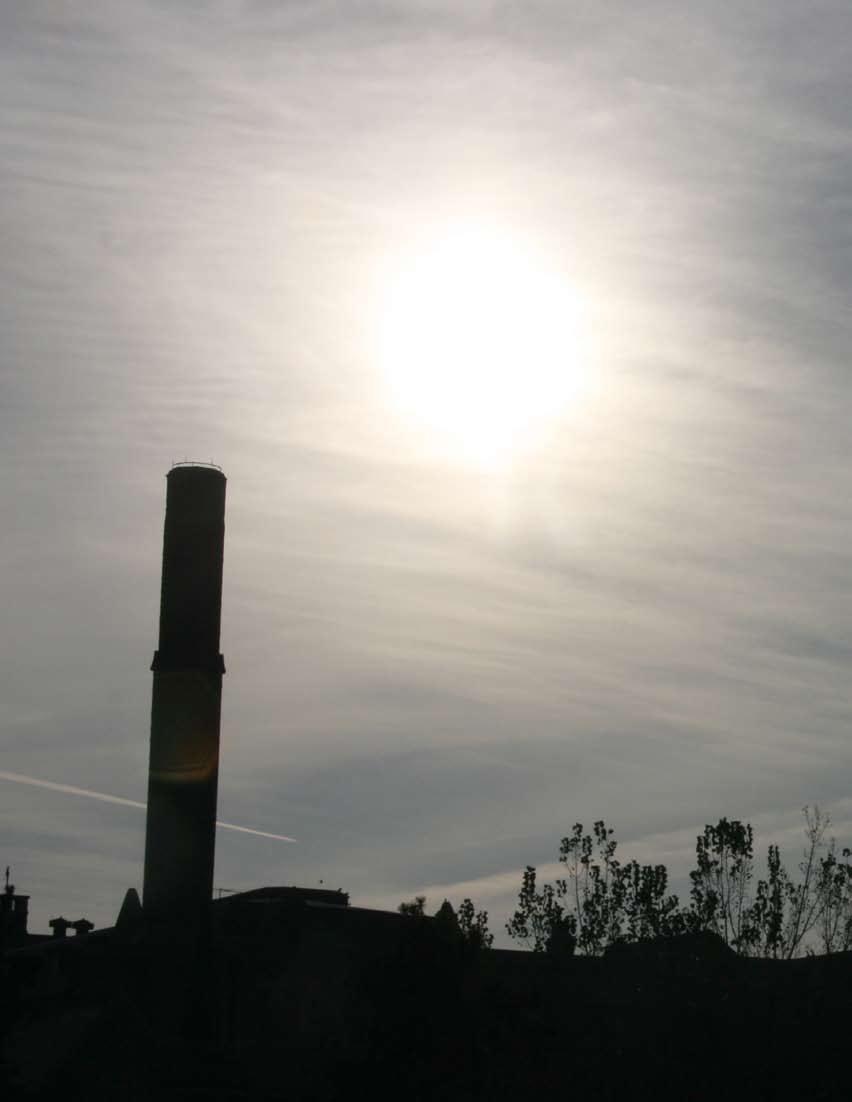
Wheat-field yellow during the day but now awash in floodlights, the high limestone walls of the Abbey Church appear as silver as the stars above in the predawn sky. Inside the front doors, met by darkness, a visitor softly pads through a set of double doors into the vastness of the nave of the church. Reaching out across the darkened pews is the distant bloom of warm light from the choir. The silence of the church is embracing rather than daunting. One by one, monks wordlessly emerge from the monastery to their assigned stalls where they await the bell signaling the utterance of the first sacred words of Vigils and Morning Prayer, the beginning of another day of prayer and work at St. Benedict’s Abbey.
From behind, Abbot Owen Purcell approaches the visitor, inviting him to join the monks in the choir. As the guest reaches the stalls, he has no time to feel apprehensive as Brother Joseph Ryan strides forward, smiling, to greet him and show him to a seat. Crouching at
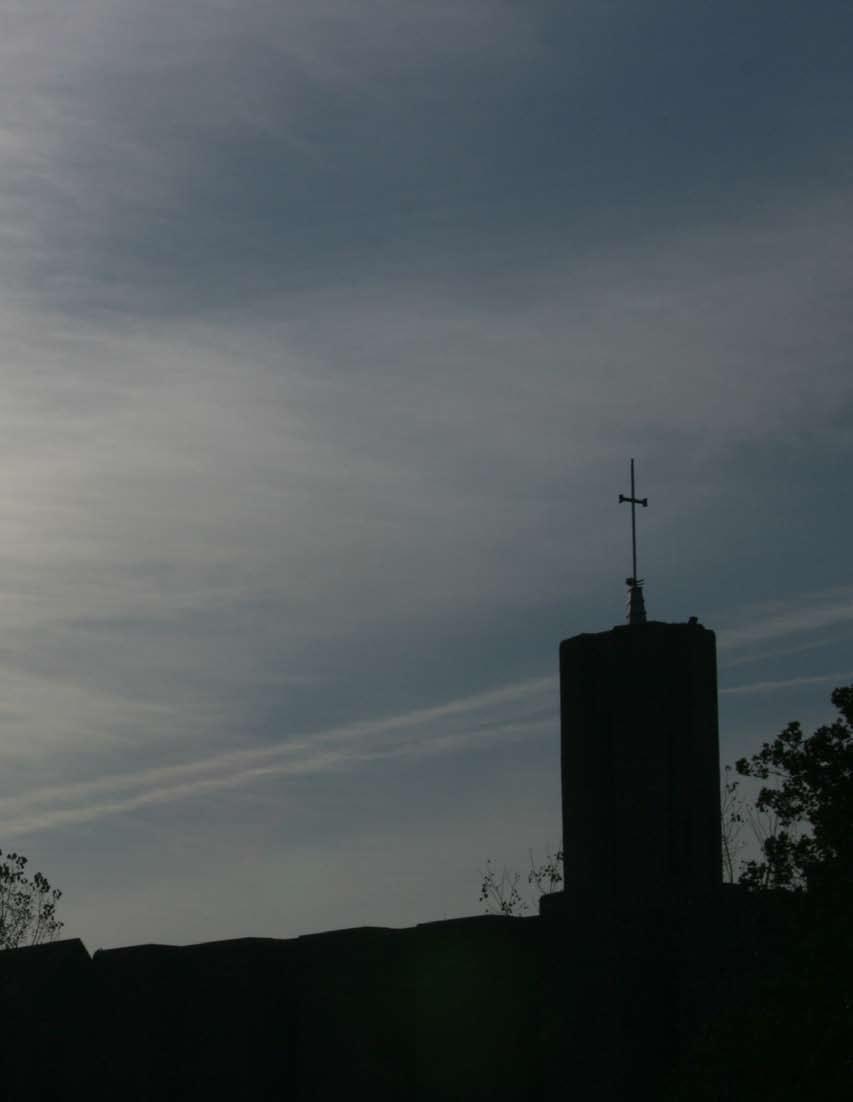
KANSAS MONKS his side, Brother Joseph opens a psalmody and a hymnal and kindly shows him the order of prayer for the morning.
A bell rings, and Prior James Albers recites the first words of a long night’s silence, “O Lord open my lips.” The monks make the sign of the cross upon their lips, and respond, “And my mouth shall declare your praise. To the king of all ages, the immortal, invisible and only God, be honor and glory for ever and ever. Amen.” Vigils have begun.
The silence of the church is rich and the words do not disrupt. Instead they seem to soak into it, as the vivid paints long ago soaked into the wet plaster of the fresco glowing in the light on the wall above the choir.
The morning hymn is carried by swells of organ and men’s voices beyond the light into the darkened corners of the church:
“Lord, God, your light which dims the stars Awakes all things
And all that springs to life in you
Your glory sings…”
Brother Joseph Ryan is the first reader during midday prayer in the Abbey Church choir.
file photo

When the monks completed the church in 1957, the Abbey’s centennial year, they wrote: “Here in the abbey church the monks can be found at worship many times daily. Benedictine spirituality through 1,400 years has centered itself in the daily chanting of God’s praises in the Divine Office and the united offerings of the Holy Sacrifices of the Mass with full splendor of music and ritual.” The monks reminded those celebrating the dedication of their new church that the monk “dedicates himself body and soul to the worship of God. He gives up his rights to private property, to the joys of marriage, and to personal freedom in order to make a sacrifice of his whole being to God’s glory… It is no wonder then, that every Benedictine community strives to build as splendid a monastic church as lies within its power in order to form a fitting place for divine worship, and to glorify God in brick and stone as well as with hearts and hands.” The monks’ plans for a new Abbey Church, in the Gothic style, were progressing when they moved into a file photo new monastery high atop the Missouri River bluff in 1929, but the Great Depression halted work after only part of the foundation had been laid. In 1934 Abbot Martin Veth lamented, “We wanted a church so badly, but we are burdened with an immense debt without hope of moving a hand.” For nearly three decades the community waited patiently to invite the public to share in their daily prayer. In the meantime, they celebrated the Eucharist and Liturgy of the Hours within their cloister, in a spacious second-floor chapel that today is the Chapter Room where the community gathers to make major decisions. That room is directly behind the massive fresco at the east end of Abbey Church.
In 1955 construction resumed. A new architect, Barry Byrne, of Chicago, a student of Frank Lloyd Wright, was commissioned. He wanted to tear up the foundation that had been laid earlier, but the monks resisted. Thus, his more contemporary “prairie style” church, which incorporated landscape, was built atop the Gothic remnants, which can be viewed in the crypt of today’s church.
In 1957, in time for the centennial of St. Benedict’s Abbey, “at long last, the entire monastic family—the monks, their students, alumni, oblates of the abbey, and numberless friends” had a “common spiritual center from which to draw inspiration, strength and unity.”
There were many long discussions in chapter meetings, and no doubt between individual monks in secluded hallways, about what
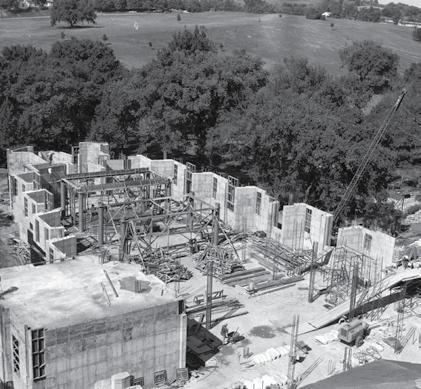
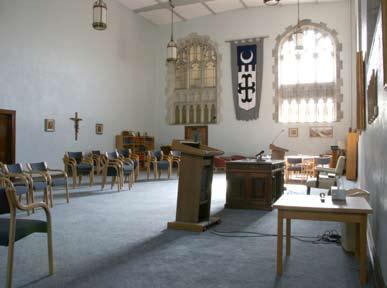
The Chapter Room was once the place for daily prayer in the Abbey.
this dream church would be. What would the center of monastic prayer look and feel like?
To be sure in those earliest of discussions, the indispensible furnishing of the yet-to-be built church was the altar.
Father Denis Meade reflects on the “monumental-sized altar” that dominates the church like a marble heart:
“The self gift of Jesus’ life gives us life. Upon the altar, Jesus’ passage through death to life is re-presented. It is the spot where the one sacrifice of the Lord is brought anew into our midst at every Mass. Simultaneously it is the table upon which the banquet of life is served to those who come forward to share in Communion. Together, these members of one body say, ‘Christ has died, Christ has risen, Christ will come again!’
“It is interesting to note that at least four years before the selection of a church design or even an architect the church committee was already discussing the altar. They wanted to get it right. In their first meetings of 1949 the committee decided that they wanted to embody classic ideals of a monastic church. This meant the altar was the space where the Eucharistic sacrifice would come to be. The Blessed Sacrament would be reserved in an adjoining chapel built
for that purpose.
“The altar was to be located between the monks’ choir and the nave of the church and constructed in such a way that Mass could be celebrated either toward the monks in choir or the people in the nave. With their thoughts of simplicity and freedom of vision the monks originally proposed that the altar be a mensa, a simple stone table upon four supporting legs. Barry Byrne, the architect, however, insisted that such an altar would be lost in the vast space of the sanctuary and persuaded them to adopt the concept of a more substantial altar; thus the large altar of Carrara marble from Italy. The brick support in the center goes down through the crypt to anchor the altar to the earth below. This was a requirement of the pre-Vatican II solemn rite of church dedication. The architect and committee were agreed that eventually this brick support would be adorned with a mosaic of bright colors, a concept as yet unrealized.
“When the church was built, public opinion among those interested in church design favored simplicity of interior decoration. Hence it was decided that the main altar would be the only altar in the principal part of the church. Instead of the traditional side altars dedicated to Mary and Joseph, two chapels in the crypt were dedicated to our Lady of Guadalupe and Saint Joseph, the Worker.
“Gathering the whole Benedictine community around one altar was a dream of the community. For a number of years the Abbey’s daily conventual Mass was celebrated at noon with the full participation of the monks and students offering and singing the Mass together.”
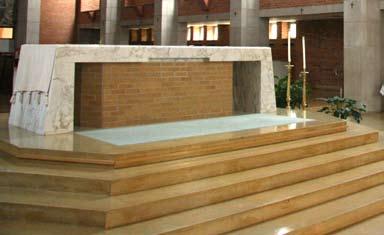
The altar is made of marble imported from Italy.
St. Benedict’s is a sturdy church, built not only to withstand but to deter the harsh elements of the Kansas plains. Like a massive ship upon a wave it rides the swell of the bluffs above the Missouri River, overlooking the floodplain where Meriwether Lewis and William Clark once camped and wrote of a land of abundant game and rich, dark soil, awaiting the plow. Father Peter Henry Lemke, years later, would venture west to the same flood plain, hoping to cultivate Catholic souls in ill-fated Doniphan, Kansas Territory. The Kansas monks who followed him would move to higher ground in Atchison, and a century later would build a church as simple and solid as old Henry.
With an exterior of Winona Limestone and an interior of Indiana Limestone and light red brick it is not difficult to share the architect’s vision of a church that is one with the prairie from which it rises. The floors are Kasota buff fleuri. The ceiling, contributing to the church’s pitch-perfect acoustics, is aluminum pan acoustic and porcelain enamel, some tiles weighing more than 50 pounds. The pews, choir stalls and all other woodwork are hewn from solid white oak.
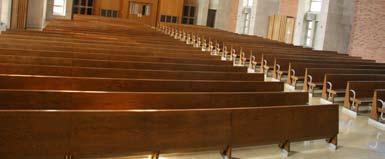
The Nave is the longest part of the Abbey Church and also houses the confession booths.
Originally, high, slender windows of clear glass were installed in the church with the intention of later replacing them with stained glass. However, in time the stained glass was abandoned as the monks recognized that the flood of natural light enhanced the natural radiance of the nave where on festive occasions hundreds of guests sit comfortably beneath the colorful ceiling soaring 44-feet overhead.
And a well lit and comfortable nave is significant, for as Father Brendan Rolling notes, those who fill it are precious cargo:
“The nave is the longest part of a church’s architecture. Inside, it can often look like a keel, the longest part of a ship. Due to this, the word is actually taken from the Medieval Latin word, “navis,” meaning ship. St. Benedict’s Abbey Church is built to look like a ship. The fresco area is the stern (back) and the entrance is the stem (front). The tower is the mast. The pews in the nave are like planks built for sailors who row for Jesus Christ.
“From the high altar cross, we can hear Jesus say, ‘I thirst.’ –John 19:28 These two words show us what he desires most. Souls. Jesus thirsts for souls. For this reason the nave is the largest part of our church. It is built to cradle what God desires most. In the Holy Rule, St. Benedict instructs his monks to generously serve God’s desire by always welcoming pilgrims. Pilgrim-souls demonstrate their love for God by imitating Jesus who traveled to mountain tops to pray. Monastery churches make this practice practical and therefore are living icons of Christ’s Transfiguration.
“The nave of our Abbey Church, like the nave of Monte Cassino’s Church, the church of St. Benedict’s first Abbey, is built to welcome and hold God’s most prized possession, His people. Millions travel to Monte Cassino’s nave while thousands travel to St. Benedict’s Abbey Church to pray each year. You are always welcome.”
In the Abbey Church the eye of most people as they enter the nave is immediately drawn to 610-square-foot fresco at the east end, and the Jean Charlot masterpiece, which captures the colors from the length of the ceiling to draw the eye deep into the heart of the glorified Christ certainly does its part to mesmerize. But, as in a monastic community, a church is a whole consisting of unified parts. On the way to the fresco, “The Trinity and Episodes of Benedictine Life,” there are quiet and simple parts of the church to be noted and reflected upon.
First, how does one arrive inside such a church? Most people and indeed all before 2007 entered the building by climbing stairs. Such was the way of church design in 1957.
With a nod to the words of St. Benedict, “All guests who present themselves are to be welcomed as Christ,” Abbot Barnabas Senecal says it became a priority of the monastic community to change that:
“While acclaimed for its design, our church was not friendly to the handicapped person due to the various elevations of the land and the building, and the restricted space dedicated to restrooms.
We hired Treanor Architects to design modifications to our church 13
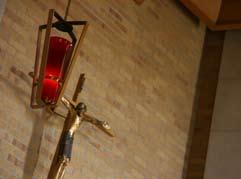

that would allow everyone access to our house of prayer. We appealed to our friends to help finance a $2.2 million dollar project under the construction management of JE Dunn. We were very pleased This ramp is one of the many new additions to the Abbey Church. in April 2007 when Archbishop Joseph Naumann dedicated the addition to the narthex with its new restroom facilities, the interior and exterior ramps and railings, and the elevator and side lift.
“When Clarence Deitchman joined us on the day we welcomed our Brazil monks and Brazil supporters, he was in a wheelchair, weakened by cancer. Luke Wenzl suffered a crushed spinal cord and has been in a wheelchair since 1968; he joined us on our Brazil day. Clarence was brother to our Father Eric; Luke had been a monk of our community. We were so pleased they could join us with some ease.
“We want our house of prayer to be available and inviting. St. Benedict would want it that way as he instructed his followers to offer hospitality to all.
“May it be so.”
The inclusive embrace of Benedictine hospitality upon which Abbot Barnabas and the monks of St. Benedict’s insist finds its foundation in the same sacred embrace of Christ represented in the walls of their church. Father Denis points to the easily overlooked ‘consecration crosses’ that line the walls of the Abbey Church: The Blessed Sacrament Chapel “The word Christ means ‘the anointed one’ and in the dedication of a church two places are anointed with oil—the altar itself and then the walls of the church building. The spots where the walls are anointed are marked with 12 crosses—representing the 12 tribes of Israel and the 12 Apostles—each holding a candle. Logically the altar is anointed first since the altar is the spot where Jesus’ sacrifice on the cross and his resurrection is renewed in the Eucharist. So Christ’s anointing spreads from the altar and reaches out to us in a loving embrace, symbolized by anointing the four walls of the church building. Christ, the anointed one, is the light of the world and our share in his consecration for us is symbolized by the light-bearing candles
Chrism, the same holy oil that is used to consecrate people to God in baptisms, confirmations and ordination is used to anoint the walls and the altar. The anointing of the crosses and walls is yet one
When the Abbey Church is empty, a profound silence can fill its expanse. Like a fortress it holds at bay prairie winds in autumn and winter, and provides cool respite from Midwest heat and humidity in July and August. Tucked away in its own cozy spot just out of view of the altar on the south side of the church is a place that seems to cradle its own special silence— the Blessed Sacrament Chapel. The small altar of Alabama cream marble holds a rectangular tabernacle flanked by candelabras. Before it are chairs and kneelers. On the wall, a delicate The candle burns in the Blessed Sacrament Chapel letting all who enter know of the presence of the Eucharist. cabinet holds chrism and other sacred oils. Above the altar, the vigil light is lit to represent the presence of Christ.
A frequent visitor, Father Bruce Swift says the chapel is haven to the Blessed Sacrament 24 hours a day, every day of the year, except for the hours after Holy Thursday Mass until the Easter Vigil: “In keeping with the simple design of the church, this chapel is not ornate. It is a place where the faithful may come and pray in front of the Blessed Sacrament. Early every morning—between 5:15 and 5:30—a few monks will be in the chapel praying. Throughout the day, monks stop in for a few moments to visit Jesus in the Sacred Species. Sometimes students come to pray or study. Teachers can be seen praying, preparing for classes, correcting papers, asking for divine
guidance for their students.
“Every Saturday night the Blessed Sacrament is moved from the tabernacle in the chapel to a monstrance on the main altar where the monks and students participate in a Holy Hour, singing the ancient songs of St. Thomas Aquinas and the Divine Praises.”
When the church is not silent, it may be filled with musical splendor. Especially if one is an enthusiast of organ music. And the Abbey’s organ has no more fervent enthusiast than Father Blaine Schultz.
“My teacher and mentor, Father Anselm Llwellyn, of happy memory, knew the importance of having a quality pipe organ for the new Abbey Church,” Father Blaine recalls. “For that reason he enlisted the services of the distinguished organist and organ builder, Ernest White, to design the 3-manual, 44-rank Moeller instrument
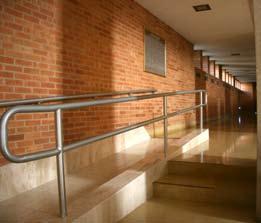
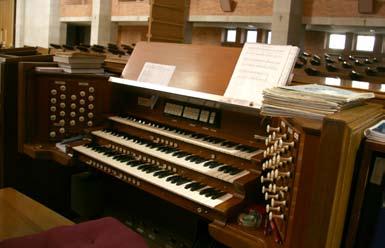
The organ is housed near the center of the Choir.
that graces the church today.”
White collaborated with the architect early on in designating the locations of future organ pipes—above the sanctuary, over the narthex, and in the choir. The console was placed in the south choir. Chambers to house the pipes were included in the church design. Two-thirds of the organ was installed in 1958, Father Blaine explains, and known as opus 9140. Almost 45 years would pass before the organ would be completed.
Father Blaine: “Since its installation 50 years ago, it has been my honor and privilege to play this magnificent instrument on a daily basis to accompany and support the monastic choir in singing psalms, hymns and canticles at the Liturgy of the Hours and daily Mass.
“According to ‘Music in Catholic Worship,’ the purpose of music in the liturgy is to ‘assist the assembled believers to express and share the gift of faith that is within them and to nourish and strengthen their interior commitment to faith.’
“I believe the beauty and brilliance of the abbey organ is due in large part to the outstanding acoustics of the room. In giving tours, I call listeners’ attention to the fact that there is no carpet or upholstered seats, the worst enemies of good sound, anywhere in the room. The hard surfaces of brick, stone and marble, plus the height of the ceilings, all contribute to exceptional acoustics.”
Exceptional is a word applied often and in many particulars to the Abbey Church. By its very nature as a church it fits the description. It has been consecrated; it is holy ground, a house sanctified.
Two striking—it has been said exceptional—pieces of art serve as constant reminders of the building’s intrinsic holiness, bold symbols of the watchfulness of the Son of God over those who sing his praises within its walls.
In tours he gives to visitors, Prior James describes the double crucifix hanging above the altar as the beginning of the singular theological narrative in Christendom, which concludes across the choir in the Charlot fresco. The double crucifix represents Christ’s passion, he says. Facing the nave, his head still lifted in the last breaths of life, is Christ crucified. Facing the choir, head slumped upon his winter 2008 chest, Christ in death. Beyond the choir, radiating from the plaster of Charlot’s fresco, Christ risen, glorified, his hands and feet, though still bearing the wounds of crucifixion, now free of the nails, his head free of the crown of thorns, all of which are held by the angels of compassion that surround him.
Of course the joy of art is its openness to interpretation.
“When I raise my eyes to look at the double-crucifix above our high altar I reflect on how avant-garde the members of the Committee on the Decoration and Ornamentation of the Abbey Church were,” Abbot Owen Purcell says of the committee directed by Fathers Malachy Sullivan and Victor Gellhaus to accomplish what the name implies. “A double crucifix was not common at all in 1957.”
Then Abbot Owen offers the interpretation of the double crucifix that sends him on his way each day: “I have often thought, and this is my own idea, that the Jesus facing the monastic choir, head bowed, dead and exhausted from suffering, can remind the viewer of the Jesus who suffered and died for our sins. The death can be looked upon as the ultimate sign of love. Ultimate in that it was the Son of God who showed this love as he said, ‘Yes’ to the Father. ‘Your will be done, not mine.’
“When I turn my attention to the Jesus facing the nave, I think of the risen Jesus with head lifted, who says to me, ‘You, go and do likewise. Say yes to the same Father. Go and tell the entire world the real Good News, which is, “I love you.” But show that very love in your own life.’”
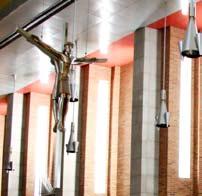
Cold rain pelts the visitor scurrying up the front steps of the Abbey Church as a dismal October night falls on Atchison. Inside, the church’s narthex is empty but warmly lit and inviting. Stepping into the nave he stops to let his eyes adjust to the darkness, and then proceeds up the center aisle toward the soft light in the choir. Somewhere high above him he hears rain and the toll of bells calling the monks to Evening Prayer. A few monks are already sitting in choir stalls. The guest takes a seat in an empty stall and Father Bruce approaches and explains the order of prayer for the evening. The rest of the monks navigate to their stalls, and Father Blaine leans into the organ. The gentle swells of music fit nicely with the soft lighting of the church.
The choir stalls are comfortable; they seem to surround and protect, like one’s own personal monastery.
Solid and permanent, they hold great strength and importance for Father Meinrad Miller, the abbey’s subprior:
“Stability is a vow Benedictine monks profess. It gives us the freedom to seek God in this one place, with our brother monks, and under an Abbot and the Rule of St. Benedict.
“For me the choir stalls symbolize this stability. Here in these stalls the monks will gather for prayer, along with our guests: students, retreatants, and others who come here to experience the peace of a Benedictine abbey.
“In each choir stall the monk has prayer books and hymnals.
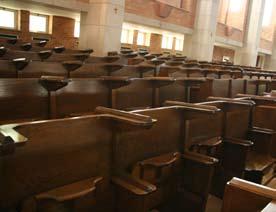
Monk’s reestablish Abbey-student mass in response to burgeoning attendance -by Fr. Brendan Rolling photo by Alzbeta Voboril
The Second Vatican Council boldly stated, “Eucharistic sacrifice is the source and summit of the Christian life.” -Dogmatic Constitution on the Church, Chapter II: The People of God
Our founder, St. Benedict, believed this over 1,500 years ago. His first act upon arriving at the top of Monte Cassino was to establish a church where his monks could celebrate the Liturgy of the Eucharist and the Liturgy of the Hours (Pope Gregory’s Dialogues, Chapter 8). He next built a monastery, library, school, and farm. The community of St. Benedict’s Abbey has demonstrated the spirit of our founder throughout our 150 year history. Our monks have built many churches. In 1957 we built the Abbey Church at the highest point, the summit, of the ground we call home. Beneath the high cross is a tower; beneath that tower is a tabernacle where we find Jesus Christ in the Eucharist. He is the source and summit of our monastic community and college.
During this year’s summer retreat, our priests and brothers voted to re-establish the Abbey-Student Mass. It was historic. Sunday Eucharist is the high point of a monk’s week. The decision to fully involve students in the monastic community’s Sunday Mass reclaimed something old and established something new. Most importantly each monk personally reaffirmed the Liturgy of the Eucharist as the source and summit of Christian life for him and for our apostolate, Benedictine College.
Something old. The Abbey-Student Mass was a custom for monks and students that started the day we founded St. Benedict’s College in 1858. Daily and Sunday Mass were a priority in the community calendar. For 100 years the AbbeyStudent Mass was celebrated in chapels and the parish church that today serves the people of Atchison at the southern edge of our land. The construction of the Abbey Church marked a milestone in the history of our community. Abbot Cuthbert McDonald set the cornerstone of the church during the community’s centennial celebration in 1957. For the first time in our 100 years the full monastic choir could worship in a church completely dedicated to that purpose and the student body had a spiritual home distinct from that of the local parishes.
Something happened. In 1957, the Abbey Church, like churches across America, was full. Then our church, like churches across America, experienced a plunge in attendance that has lasted more than 40 years. The Abbey-Student Mass disappeared along with our memories of a full church. A study done this year said, “No other major faith in the U.S. has experi-
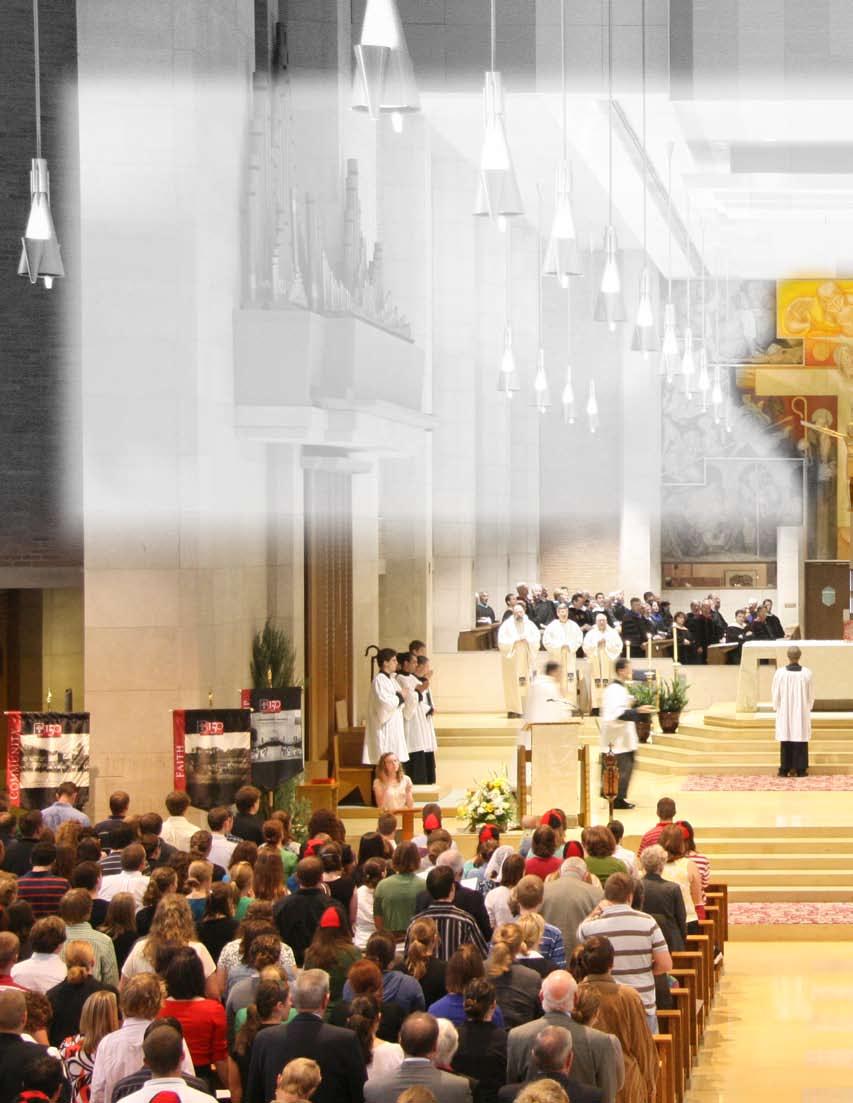
enced greater net losses than the Catholic Church” (Pew Forum, Religious Landscape Survey 2008).
Today, something new and positive is happening. Benedictine College chaplains report students are attending Masses in record numbers and fighting the tide of negative national trends. Only a few years ago, there were only 10 students at daily Mass. Today, we estimate between 300 and 400. At one time, there was one daily Mass for students. Today there are four. A while back, there was no adoration. Today, there is twenty-four hour adoration and as many as 15 students can be found in the chapel at a time. Over the last 20 years, Benedictine College produced about 40 vocations to the priesthood and religious life. Last year alone 26 students and alumni announced their intent to enter discernment. Only a few years ago there was plenty of pew space in our chapels and churches. Last year, there were times when there was standing room only. This is what 85 percent enrollment growth feels like! Over the years, Mass times and locations have been added, but these did not keep pace with the growing faithlife of our student body. While many colleges experienced short-falls in enrollment, Benedictine reported its largest freshmen class in history. What began as a small trend just 10 years ago is now an impressive statistic that
Benedictine chaplains brought to everyone’s attention last year. We now estimate that over 50 percent of our student body regularly attends Sunday Mass. More than 700 students at Sunday Mass!
To celebrate the first 100 years of St. Benedict’s Abbey, priests, brothers, and alumni combined forces to build a church. To celebrate the 150th anniversary of the Abbey and College, the community of St. Benedict’s Abbey voted to fill the church we built by re-establishing the Abbey-Student Mass. More than 50 years after it was built, the church is full again with hundreds of students who are returning to the Mass. They now have a church, a common spiritual home, where they can worship together under the pastoral care of their Benedictine Fathers.
The Prophet Isaiah says, “Look to the rock from which you were cut and to the quarry from which you were hewn” (Isa 51:1). This Scripture says to us, “Remember where you came from.” We did. We built what St. Benedict built and now the Holy Spirit is filling it. The young are responding to Pope John Paul’s call for a new evangelization and to Pope Benedict’s recent call for a New Pentecost. At this summer’s World Youth Day Pope Benedict called down the Holy Spirit and asked for a “new generation of apostles.” By re-establishing the AbbeyStudent Mass at the top of this hill, the community of St. Benedict’s Abbey joins Pope Benedict and all the Fathers of the Second Vatican Council in saying, “Eucharistic sacrifice is the source and summit of the Christian life.” U.I.O.G.D.
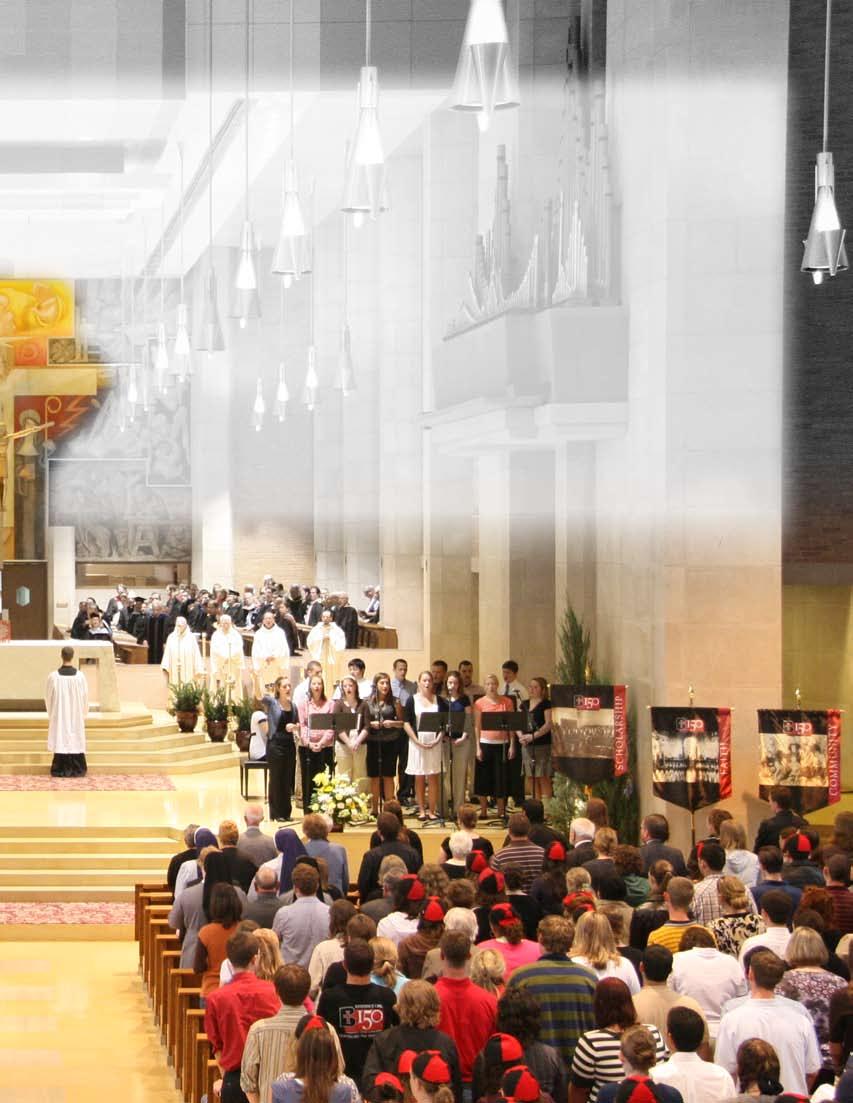
Continued from page 15
In addition, monks keep books in their choir stall for private Lectio Divina.
“When the Abbey Church was being built, Father Denis and others were asked to send the plans for the choir stalls from the Abbey of Sant’ Anselmo in Rome. They did, and the result is that our choir stalls provide a noble simplicity by which we can praise God both in our liturgical prayer, and in our private prayer.”
The evening psalms and hymns are filled with comforting praise for God’s justice, compassion and forgiveness.
Perhaps due to a lack of discipline or simply an appreciation for and wonder at the beauty of bold works of art, the guest’s eye wanders to the huge fresco on the wall above the chanting monks. God the Father and Christ the risen Son in Charlot’s work are painted in the same warm colors that light the church on this fall evening. The hands of the figures in the fresco are large and strong, ready to embrace all present.
The fresco is a form of art in which the paints are applied when the plaster was newly laid and still moist. The pigments penetrated the surface, so that when the plaster dries, the painting would enjoy a life expectancy of many centuries. It has been said that church art is a constant prayer lifted to God even when the church is empty. However, when the monks and their guests are present, this particular piece of artwork seems to sing along with them.
Father Meinrad explains the fresco’s message:
“In 1938, the French artist, Jean Charlot, was commissioned by Time magazine to paint a Nativity scene for the front cover of the Christmas 1938 edition. That year Adolph Hitler had ruled that Christ would not be part of the German celebration of Christmas. Time magazine reported in that issue about that, and many other places where Christianity was undergoing persecution.
“In 1958 Charlot was asked to paint the frescos in the Abbey Church here. For 50 years the monks and our guests have daily gathered in the Abbey Church to pray the Psalmody of the Liturgy of the Hours, and to enter into the daily celebration of the Eucharist under the Charlot fresco.
“Charlot captured the central themes of our monastic life in this main fresco. In the middle of the fresco is the life of the Trinity. The scenes in the four corners were chosen from Benedictine life: 1) the raising of the monk after a wall had fallen upon him. 2) The driving out of the devil from the rock, so the monks could build the monastery. 3) The founder of our Abbey, Father Henry Peter Lemke giving his bed to a dying man in Doniphan whom he had brought back to the Church. 4) The different works of the monks.
“These themes of healing, spiritual warfare, charity, and working together for the common good flow from the life of the Trinity. The fresco leads us beyond looking at ourselves as independent agents to seeing the unity that is ours in Christ. Of course, the Angels depicted in the fresco, who aided Christ in his passion, also aid us in following after.
Toward the end of Evening Prayer, the monks bow and sing:
“Give praise to the Father Almighty,
To his Son Jesus Chirst,
To the Spirit who dwells in our hearts…”
Lifting their heads, they finish…
“Both now and for ever, Amen.”
St. Benedict wrote in his Rule, “After the Work of God, all should leave in complete silence with reverence for God…”
Two by two, the monks file out of the church, until only Father Blaine remains, straightening up sheet music at the organ. Soon he leaves. Later, the lights are turned off. And almost imperceptible in the darkness is the whisper of the heavy rain that is still falling outside. 18 “Here is my servant whom I uphold, my chosen one with whom I am pleased, upon whom I have put my spirit.” Isaiah 42:1 A Jean Charlot fresco in St. Benedict’s Abbey Church, Atchison, portrays the Risen Christ as One within the Trinity.
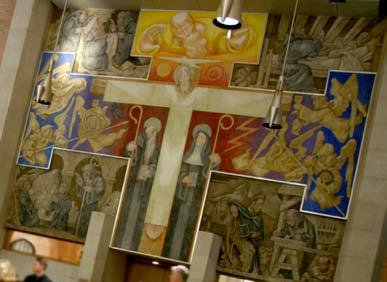
-A Powerful, Generative Love by Abbot Barnabas Senecal
Stories told, painted in plaster, Gregory and Peter - writers, Charlot - reader of their works, schooled in fresco and in faith.
These acts of moving stone, saving lives through blessing, aiding a victim of Civil War, riding horseback to distant posts;
These acts, possible by grace, reflect lives lived intentionally, binding monks to others in imitation of Christ Himself.
Central to this work of art, central to the work of life, is the Mystery of Three in One, the Mystery of Christ Alive!
Protective hands of loving Father, seeing hands of Son unpinned, expresses joy and oneness with courageous, Risen Son.
A jet-like Spirit hovers near, between Father and Son, a powerful, generative Love, active in God and us.



